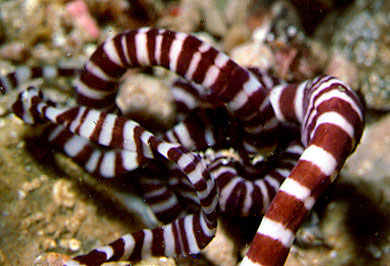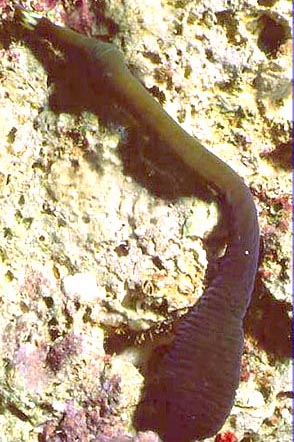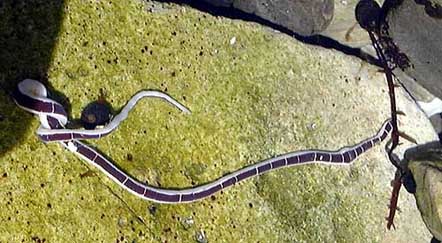 There are about 900 known species in the phylum Nemertini
(also spelled Nemertina or Nemertea by different authors).
Nemertines are known as "ribbon worms" because of the great length of
many species; the European nemertine Lineus longissimus has been
known to reach 30 meters (nearly 100 ft) in length, although most are much
shorter. Most nemertines are marine, but there are
a few freshwater species, and even a few species that live in moist
tropical habitats on land. The beautifully banded marine nemertine
shown to the left, Basiodiscus mexicanus, was photographed at Los Arcos,
near Puerto Vallarta, Mexico.
There are about 900 known species in the phylum Nemertini
(also spelled Nemertina or Nemertea by different authors).
Nemertines are known as "ribbon worms" because of the great length of
many species; the European nemertine Lineus longissimus has been
known to reach 30 meters (nearly 100 ft) in length, although most are much
shorter. Most nemertines are marine, but there are
a few freshwater species, and even a few species that live in moist
tropical habitats on land. The beautifully banded marine nemertine
shown to the left, Basiodiscus mexicanus, was photographed at Los Arcos,
near Puerto Vallarta, Mexico.
 The most distinctive feature of nemertines is a large proboscis, which
you can clearly see in the image to the right.
In one group of nemertines is tipped with a piercing barb known as a
stylet.
In other nemertines, the proboscis is unarmed, but often
secretes sticky fluid. Normally, this proboscis is retained in a specialized
sac in the animal's body, the rhynchocoel. To capture prey, the
proboscis is rapidly everted (turned inside-out) and shot out of the
rhynchocoel. It wraps around the prey, and toxic secretions immobilize the
prey; nemertines with stylets use them to stab the prey repeatedly,
introducing toxins into the body. Generally, nemertines are carnivorous; most
feed on small invertebrates like crustaceans and annelids, but some feed on
the eggs of other invertebrates, and a few live inside the mantle cavity of
molluscs and feed on microbes filtered out by the host.
The most distinctive feature of nemertines is a large proboscis, which
you can clearly see in the image to the right.
In one group of nemertines is tipped with a piercing barb known as a
stylet.
In other nemertines, the proboscis is unarmed, but often
secretes sticky fluid. Normally, this proboscis is retained in a specialized
sac in the animal's body, the rhynchocoel. To capture prey, the
proboscis is rapidly everted (turned inside-out) and shot out of the
rhynchocoel. It wraps around the prey, and toxic secretions immobilize the
prey; nemertines with stylets use them to stab the prey repeatedly,
introducing toxins into the body. Generally, nemertines are carnivorous; most
feed on small invertebrates like crustaceans and annelids, but some feed on
the eggs of other invertebrates, and a few live inside the mantle cavity of
molluscs and feed on microbes filtered out by the host.
Nemertines were once classified close to the
flatworms, which they superficially resemble.
Like flatworms, nemertines are soft and unsegmented. However, nemertines have
major features that flatworms lack, notably a complete gut with an anus, and
a system of blood vessels. This vessel system may in fact be homologous with
the coelom, or fluid-filled lined body cavity, found in many
other invertebrates. Flatworms lack a coelom entirely, and this suggests
that nemertines are not close relatives of flatworms. Recent
molecular studies have tended to confirm this view, placing nemertines
among the trochozoan coelomates such
as annelids and
molluscs than to flatworms.
 The fossil record of nemertines is extremely sparse, as would be expected
for this completely soft-bodied group. The stylets of nemertines would be
expected to survive as fossils, since they are made of the mineral
calcium phosphate, but none have been reported so far. The only fossil that
may be a nemertine is Archisymplectes from the Pennsylvanian-age
Mazon Creek biota
of northern and central Illinois. Even this fossil only preserves the outline
of the worm, and it is not absolutely certain that it represents a nemertine.
The Cambrian fossil
Amiskwia from the Burgess Shale has been classed as a nemertine,
based on a resemblance to certain aberrant deep-sea swimming forms. This is
not currently accepted by many paleontologists.
The fossil record of nemertines is extremely sparse, as would be expected
for this completely soft-bodied group. The stylets of nemertines would be
expected to survive as fossils, since they are made of the mineral
calcium phosphate, but none have been reported so far. The only fossil that
may be a nemertine is Archisymplectes from the Pennsylvanian-age
Mazon Creek biota
of northern and central Illinois. Even this fossil only preserves the outline
of the worm, and it is not absolutely certain that it represents a nemertine.
The Cambrian fossil
Amiskwia from the Burgess Shale has been classed as a nemertine,
based on a resemblance to certain aberrant deep-sea swimming forms. This is
not currently accepted by many paleontologists.
|
 There are about 900 known species in the phylum Nemertini
(also spelled Nemertina or Nemertea by different authors).
Nemertines are known as "ribbon worms" because of the great length of
many species; the European nemertine Lineus longissimus has been
known to reach 30 meters (nearly 100 ft) in length, although most are much
shorter. Most nemertines are marine, but there are
a few freshwater species, and even a few species that live in moist
tropical habitats on land. The beautifully banded marine nemertine
shown to the left, Basiodiscus mexicanus, was photographed at Los Arcos,
near Puerto Vallarta, Mexico.
There are about 900 known species in the phylum Nemertini
(also spelled Nemertina or Nemertea by different authors).
Nemertines are known as "ribbon worms" because of the great length of
many species; the European nemertine Lineus longissimus has been
known to reach 30 meters (nearly 100 ft) in length, although most are much
shorter. Most nemertines are marine, but there are
a few freshwater species, and even a few species that live in moist
tropical habitats on land. The beautifully banded marine nemertine
shown to the left, Basiodiscus mexicanus, was photographed at Los Arcos,
near Puerto Vallarta, Mexico.
 The most distinctive feature of nemertines is a large proboscis, which
you can clearly see in the image to the right.
In one group of nemertines is tipped with a piercing barb known as a
stylet.
In other nemertines, the proboscis is unarmed, but often
secretes sticky fluid. Normally, this proboscis is retained in a specialized
sac in the animal's body, the rhynchocoel. To capture prey, the
proboscis is rapidly everted (turned inside-out) and shot out of the
rhynchocoel. It wraps around the prey, and toxic secretions immobilize the
prey; nemertines with stylets use them to stab the prey repeatedly,
introducing toxins into the body. Generally, nemertines are carnivorous; most
feed on small invertebrates like crustaceans and annelids, but some feed on
the eggs of other invertebrates, and a few live inside the mantle cavity of
molluscs and feed on microbes filtered out by the host.
The most distinctive feature of nemertines is a large proboscis, which
you can clearly see in the image to the right.
In one group of nemertines is tipped with a piercing barb known as a
stylet.
In other nemertines, the proboscis is unarmed, but often
secretes sticky fluid. Normally, this proboscis is retained in a specialized
sac in the animal's body, the rhynchocoel. To capture prey, the
proboscis is rapidly everted (turned inside-out) and shot out of the
rhynchocoel. It wraps around the prey, and toxic secretions immobilize the
prey; nemertines with stylets use them to stab the prey repeatedly,
introducing toxins into the body. Generally, nemertines are carnivorous; most
feed on small invertebrates like crustaceans and annelids, but some feed on
the eggs of other invertebrates, and a few live inside the mantle cavity of
molluscs and feed on microbes filtered out by the host.
 The fossil record of nemertines is extremely sparse, as would be expected
for this completely soft-bodied group. The stylets of nemertines would be
expected to survive as fossils, since they are made of the mineral
calcium phosphate, but none have been reported so far. The only fossil that
may be a nemertine is Archisymplectes from the Pennsylvanian-age
The fossil record of nemertines is extremely sparse, as would be expected
for this completely soft-bodied group. The stylets of nemertines would be
expected to survive as fossils, since they are made of the mineral
calcium phosphate, but none have been reported so far. The only fossil that
may be a nemertine is Archisymplectes from the Pennsylvanian-age


